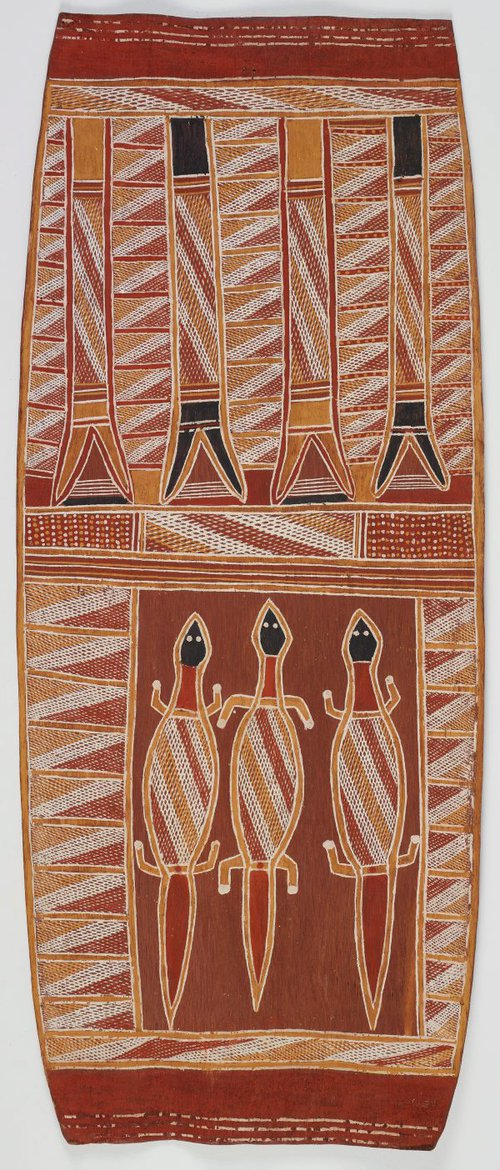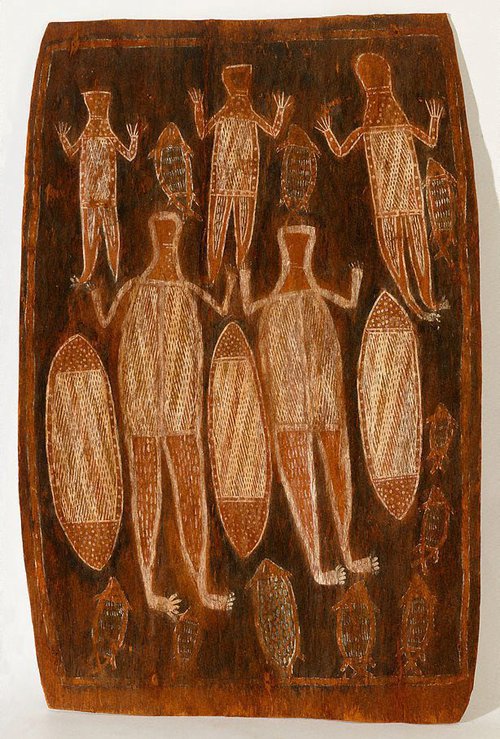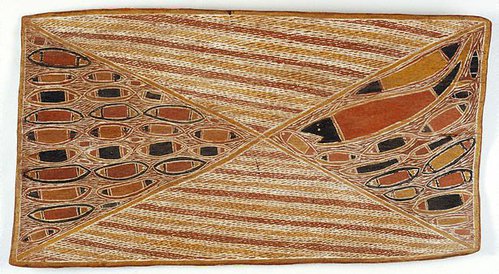Title
Banumbirr (morning star)
collected 1948
Artist
-
Details
- Other Title
- Aboriginal heaven
- Alternative title
- Dhuwa journey of the dead - Aboriginal heaven
- Place where the work was made
-
Milingimbi
→
Central Arnhem Land
→
Northern Territory
→
Australia
- Cultural origin
- Djambarrpuyŋu/Arnhem region
- Date
- collected 1948
- Media category
- Painting
- Materials used
- natural pigments on paper
- Dimensions
- 58.0 x 45.5 cm image/sheet; 76.0 x 63.5 x 3.0 cm frame
- Signature & date
Not signed. Not dated.
- Credit
- Gift of the Commonwealth Government 1956
- Location
- Not on display
- Accession number
- 9283
- Copyright
- © Binyinyuwuy Estate. Licensed by Aboriginal Artists Agency Ltd
- Artist information
-
 Binyinyuwuy Djarrankuykuy
Binyinyuwuy Djarrankuykuy
Works in the collection
- Share
-
-
About
Binyinyuwuy was only a young man at the time of painting this work and it is perhaps the earliest work by him to have been collected and attributed. It was made as part of the American and Australian Scientific Expedition to Arnhem Land led by Charles Mountford, which resulted in a collection of several hundred Aboriginal objects and artworks.
Central within Banumbirr (morning star) is the morning star pole. Each evening the morning star leaves its bathi (basket) to travel across the country on a feathered string, passing over Dhuwa estates such as Djarraya (Napier Peninsula), which is Binyinyuwuy’s home country, and guiding the souls of those recently departed to the island of Burralku. By morning, the star is returned to the bathi until the following evening, when it will repeat the journey. As explained by Djambarrpungu-man Keith Lapulung Dhamarrandji, Burralku is akin to heaven, a ‘promised spiritual country, the next stage of life after death. Life repeats then moves on to the next cycle’.
-
Places
Where the work was made
Milingimbi
-
Exhibition history
Shown in 3 exhibitions
Mountford Gifts: Works from the American Australian scientific expedition to Arnhem Land 1948, Art Gallery of New South Wales, Sydney, 21 Mar 2009–03 Jun 2009
Art from Milingimbi: taking memories back, Art Gallery of New South Wales, Sydney, 12 Nov 2016–29 Jan 2017
Under the Stars, Art Gallery of New South Wales, Sydney, 21 Mar 2020–07 Feb 2021
-
Bibliography
Referenced in 5 publications
-
Edmund Capon AM, OBE, Steven Miller, Tony Tuckson, James Scougall, Mollie Gowing, Harry Messel, Craig Brush, Ronald Fine, Alison Fine, Gordon Davies, Rosalind Davies, Christopher Hodges, Helen Eager, Rosemary Gow, Sandra Phillips, Daphne Wallace and Ken Watson, Gamarada, Sydney, 1996, 6 (colour illus.).
-
Jonathan Jones, Mountford Gifts: Works from the American-Australian scientific expedition to Arnhem Land 1948, 'Mountford Gifts: Works from the American-Australian scientific expedition to Arnhem Land 1948', pg. 1-5, Sydney, 2009, 3, 4.
-
Charles P Mountford (Editor), Records of the American-Australian scientific expedition to Arnhem Land 1: Art, myth and symbolism, Melbourne, 1956, 328, (illus.). plate no. 101 'A'
-
National Art Gallery of New South Wales, Purchases and Acquisitions for 1956 National Art Gallery of N.S.W., Sydney, 1956, 23. cat.no. 64; titled 'Aboriginal heaven'
-
Cara Pinchbeck, Art from Milingimbi, ‘Binyinyuwuy’, pg. 44-59, Sydney, 2016, 40 (colour illus., detail), 48 (colour illus.), 142.
-




